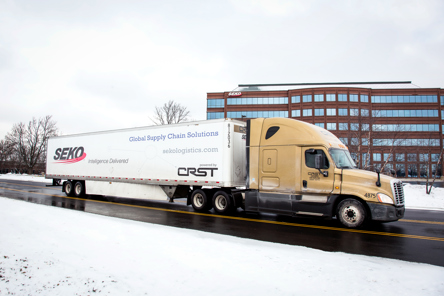In the intricate world of healthcare logistics, the safe shipping of delicate medical devices is of paramount importance. At SEKO Logistics, we have honed our expertise in handling sensitive medical equipment, ensuring nothing is damaged in any way during transit. This article will address the significance of proper packaging for these delicate devices, the considerations to bear in mind, and the regulations that govern this process.
IMPORTANCE OF PROPER PACKAGING FOR SHIPPING DELICATE MEDICAL DEVICES
The healthcare industry is characterized by a constant evolution of medical devices, many of which are delicate and require meticulous handling. The packaging of these devices is not just about containment; it's about providing a protective shell that can withstand the rigors of transportation, handling, and storage.
Improper packaging can lead to device damage, which can have serious implications, including delayed medical procedures, increased costs, and potential harm to patients. SEKO understands these risks and have developed robust packaging strategies to ensure the safe delivery of medical devices.
KEY CONSIDERATIONS WHEN CHOOSING PACKAGING MATERIALS
Choosing the right packaging materials for delicate medical devices is a critical decision that can significantly impact their safety during transit. Several factors come into play, including the device's fragility, size, weight, and value.
The packaging material should provide ample cushioning to absorb shocks and vibrations during transportation. It should also be resistant to punctures and tears. Furthermore, the packaging should be suitable for the device's storage conditions, considering factors such as temperature, humidity, and exposure to light.
COMMON PACKAGING MATERIALS FOR SHIPPING DELICATE MEDICAL DEVICES
There is a wide array of packaging materials available for shipping delicate medical devices. These include corrugated boxes, foam inserts, bubble wrap, and air pillows. Each of these materials has its own set of advantages and potential drawbacks.
Corrugated boxes are sturdy and provide good protection against external impacts. Foam inserts can be custom-made to fit the shape of the device, offering excellent cushioning. Bubble wrap and air pillows are lightweight and flexible, making them ideal for filling voids in the packaging.
THE ROLE OF CUSHIONING AND PADDING IN PROTECTING DELICATE MEDICAL DEVICES
Cushioning and padding are the unsung heroes of packaging, playing a pivotal role in safeguarding delicate medical devices during shipping. They serve as a protective barrier, absorbing shocks and vibrations that could otherwise damage the devices.
Different types of cushioning and padding materials are available, each with its own unique properties. Foam, for instance, is a versatile material that can be custom-cut to fit the shape of the device, offering excellent cushioning and insulation. Bubble wrap, on the other hand, is lightweight and flexible, making it ideal for filling voids in the packaging and providing additional protection. Air pillows are another popular choice, offering excellent shock absorption while being lightweight and space-efficient.
The choice of cushioning and padding material depends on several factors, including the device's fragility, weight, and size. For instance, heavier devices may require denser cushioning materials to adequately absorb shocks. Similarly, highly fragile devices may benefit from custom-cut foam inserts that provide a snug fit and minimize movement within the package.
REGULATIONS AND GUIDELINES FOR PACKAGING AND SHIPPING MEDICAL DEVICES
The packaging and shipping of medical devices are subject to stringent regulations and guidelines designed to ensure safety and compliance. These regulations, set forth by bodies such as the U.S. Food and Drug Administration (FDA) and the International Organization for Standardization (ISO), stipulate the requirements for labeling, documentation, and testing of packaging systems.
For instance, medical devices must be clearly labeled with information such as the manufacturer's name, the device's name, and any necessary warnings or instructions. The packaging must also be robust enough to withstand normal transportation conditions and must be tested to verify its performance.
Documentation is another crucial aspect of compliance. Records must be kept of all packaging and shipping processes, including the materials used, the methods of packaging, and any testing carried out. This documentation helps to demonstrate compliance in the event of an audit and can also be invaluable in tracing the root cause of any issues that may arise.
Non-compliance with these regulations can result in severe penalties, including fines and the potential withdrawal of the product from the market. Moreover, it can damage a company's reputation and erode customer trust.
ENSURING SAFE TRANSIT IS THE SEKO WAY
The safe shipping of delicate medical devices is a complex process that requires careful consideration of various factors, including the choice of packaging materials, the use of cushioning and padding, and adherence to regulations. SEKO has the expertise and experience to ensure the safe transit of your medical devices, offering peace of mind and reliability.
FREQUENTLY ASKED QUESTIONS
WHY IS PROPER PACKAGING IMPORTANT FOR SHIPPING DELICATE MEDICAL DEVICES?
Proper packaging is crucial for protecting delicate medical devices from damage during transit. It absorbs shocks and vibrations, prevents contamination, and ensures the device reaches its destination in optimal condition.
WHAT ARE THE KEY CONSIDERATIONS WHEN CHOOSING PACKAGING MATERIALS FOR DELICATE MEDICAL DEVICES?
The key considerations include the device's fragility, size, weight, and value, as well as the storage conditions. The packaging material should provide adequate cushioning, be resistant to punctures and tears, and be suitable for the device's storage conditions.
WHAT TYPES OF PACKAGING MATERIALS ARE COMMONLY USED FOR SHIPPING DELICATE MEDICAL DEVICES?
Common packaging materials include corrugated boxes, foam inserts, bubble wrap, and air pillows. The choice of material depends on the device's characteristics and the specific requirements of the shipment.
HOW DOES CUSHIONING AND PADDING PROTECT DELICATE MEDICAL DEVICES DURING SHIPPING?
Cushioning and padding absorb shocks and vibrations during transit, reducing the risk of damage to the device. They also fill voids in the packaging, preventing the device from moving around.
ARE THERE SPECIFIC REGULATIONS OR GUIDELINES FOR PACKAGING AND SHIPPING MEDICAL DEVICES?
Yes, there are specific regulations and guidelines that govern the packaging and shipping of medical devices. These cover aspects such as labeling, documentation, and testing of packaging systems. Compliance with these regulations is crucial to ensure safety and avoid penalties.





